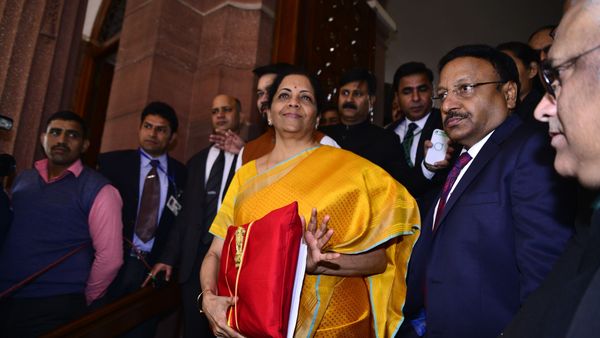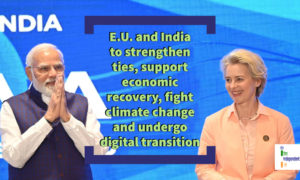
Sitharaman announces new tax slabs and raises custom duty in her Union Budget speech 2020-21
Presenting the Union Budget 2020-21 on Saturday, i.e., February 1, 2020, the Finance Minister of India – Nirmala Sitharaman said the fundamentals of the India economy are strong and that inflation has been contained well.
During her marathon speech, she announced cuts in personal income tax, extension of tax benefits for affordable housing and breather to companies on payment of dividend. She stated that the Government is keen to boost consumption and put an end to the economic slump.
Terming the new budget as “Jan Jan Ka Budget (Budget of the People)”, the Prime Minister of India – Narendra Modi tweeted, “The first Budget of this new decade is a #JanJanKaBudget. It combines futuristic vision with a definitive action plan for growth. The Budget will boost income, investment, demand and consumption. It will strengthen our financial systems and the credit flow.”
The first Budget of this new decade is a #JanJanKaBudget. It combines futuristic vision with a definitive action plan for growth. The Budget will boost income, investment, demand and consumption. It will strengthen our financial systems and the credit flow.
— Narendra Modi (@narendramodi) February 1, 2020
In the new budget, the customs duty has been raised on a number of products ranging from tableware and kitchenware, electrical appliances to footwear, furniture, stationery and toys. The idea is to provide an equal opportunity to Indian companies and promote Modi’s ‘Make in India’ initiative.
The budget also proposes new tax slabs of 15% and 25% in addition to the existing slabs of 10%, 20% and 30%. These new Income Tax (I-T) slabs would be for individuals not availing certain specified deductions or exemptions.
In the new budget, income upto Rs. 2.5 lakhs is exempted from tax. Income between Rs. 2.5 lakhs to Rs. 5 lakhs will attract a tax of 5%. Those earning between Rs. 5 lakhs and Rs. 7.5 lakhs will be taxed at 10%. People with income between Rs. 7.5 lakhs and Rs. 10 lakhs will have to pay 15% tax. Income between Rs. 10 lakhs and Rs. 12.5 lakhs will be taxed at 20%. While tax on income between Rs. 12.5 lakhs to Rs. 15 lakhs would be 25%, the tax on income above Rs. 25 lakhs would be 30%.
Notably, individuals opting for taxation under new rates will not be entitled to exemption / deductions including under Section 80C and 80D, LTC, housing rent allowance, deduction for entertainment allowance, professional tax, and interest on self-occupied / vacant property.
Speaking on the occasion, Sitharaman said, “The new tax regime shall be optional for taxpayers.”
She added, “The proposed tax structure will provide significant relief to taxpayers and more so to those in the middle class.”
She also said that higher spending on infrastructure, rural development and agricultural sector are required to boost growth. She also highlighted in her speech that Government has insured 6.11 crores farmers under the Pradhan Mantri Fasal Bima Yojna.
She also hiked the fiscal deficit target for current fiscal to 3.8% of the Gross Domestic Product (GDP) from 3.3%. Most importantly, she pegged the fiscal deficit at 3.5%. Here is the sector-wise glimpse of gainers and losers from the budget.
Talking about the budget, Modi tweeted, “#JanJanKaBudget includes many reforms. It also lays out a plan to boost employment generation in important sectors of the economy. I am particularly delighted that there is an extensive focus on doubling farmer incomes in the Budget. It will help crores of hardworking farmers.”
#JanJanKaBudget includes many reforms. It also lays out a plan to boost employment generation in important sectors of the economy.
— Narendra Modi (@narendramodi) February 1, 2020
I am particularly delighted that there is an extensive focus on doubling farmer incomes in the Budget. It will help crores of hardworking farmers.
He further tweeted, “The #JanJanKaBudget strives to reduce the tax burden and put more money in the hands of the common man. With measures like ‘Vivad Se Viswas’ and faceless appeals, litigation will be reduced and there will be greater trust in the system.”
The #JanJanKaBudget strives to reduce the tax burden and put more money in the hands of the common man.
— Narendra Modi (@narendramodi) February 1, 2020
With measures like ‘Vivad Se Viswas’ and faceless appeals, litigation will be reduced and there will be greater trust in the system.
Congratulating Sitharaman, Modi tweeted, “Steps like establishing a common online exam for government jobs, Kisan Rail and Krishi Udaan are going to have long term benefits for a cross section of citizens. I congratulate FM @nsitharaman Ji, MoS @ianuragthakur Ji and the entire team that that worked on #JanJanKaBudget.”
Steps like establishing a common online exam for government jobs, Kisan Rail and Krishi Udaan are going to have long term benefits for a cross section of citizens.
— Narendra Modi (@narendramodi) February 1, 2020
I congratulate FM @nsitharaman Ji, MoS @ianuragthakur Ji and the entire team that that worked on #JanJanKaBudget.
WATCH HERE WHAT PM HAS TO SAY ON BUDGET
Who all benefited?
Sitharaman proposed a corpus of Rs. 1.7 trillion (U.S. $ 23.7 billion) for transport infrastructure that includes the accelerated development of highways and plans to monetize 12 lots of highway bundles.
The farm and rural sectors have been allocated Rs. 2.83 trillion, while the agriculture credit target for next year is set at Rs. 15 trillion. The Government is also planning to expand fisheries and create 500 fish farmer producer organizations.
The services of Indian Railways will be equipped with air-conditioned freight cars and the Government will provide viability gap funding for warehousing. Container Corporation of India Ltd. is set to be the biggest winner off the announcements on freight trains, cold storage and warehousing.
The Government also plans to provide piped water across Indian households by 2024 with an investment of Rs. 3.6 trillion. Besides, Rs. 123 billion have been dedicated to Modi’s ‘Swachh Bharat’ Mission. She also mentioned plans to bring broadband to villages and Rs. 60 billion have been allocated for this initiative.
The biggest benefit was provided to education sector with a funding of Rs. 99 billion. Not to forget, India will expand its national gas grid to 27,000 kms form the present stretch of 16,200 kms.
Who all suffered?
Sitharaman’s announcement of selling part stake in Life Insurance Corporation (LIC) of India triggered decline in shares of private insurers.
The budget remained silent on infusing new capital into State-run banks for 2020-21. This would impact the functioning of State Bank of India (SBI), Bank of Baroda, Canara Bank, Union Bank of India (UBI), Bank of India (BOI) and Punjab National Bank (PNB).
She also read out a renewed focus on zero-budget farming which significantly cuts down on fertilizer consumption. Separately, there were no announcements for Real Estate industry.







